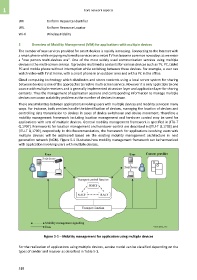Page 528 - 5G Basics - Core Network Aspects
P. 528
1 Core network aspects
URI Uniform Resource Identifier
URL Uniform Resource Locator
Wi-Fi Wireless Fidelity
5 Overview of Mobility Management (MM) for applications with multiple devices
The number of new services provided for smart devices is rapidly increasing. Connecting to the Internet with
a smart phone while enjoying multimedia services on a smart TV has become common nowadays as we enter
a "one person multi-devices era". One of the most widely used communication services using multiple
devices is the multi-screen service. It provides multimedia contents for various devices such as TV, PC, tablet
PC and mobile phone without interruption while switching between these devices. For example, a user can
watch video with TV at home, with a smart phone in an outdoor area and with a PC in the office.
Cloud computing technology which distributes and stores contents using a local server system for sharing
between devices is one of the approaches to realize multi-screen service. However it is only applicable to one
source with multiple receivers and is generally implemented at session layer and application layer for sharing
contents. Thus the management of application sessions and corresponding information to manage multiple
devices can cause scalability problem as the number of devices increase.
There are similarities between applications involving users with multiple devices and mobility service in many
ways. For instance, both services handle the identification of devices, managing the location of devices and
controlling data transmission to devices in cases of device switchover and device movement. Therefore a
mobility management framework including location management and handover control may be used for
applications with sets of multiple devices. General mobility management framework is specified in [ITU-T
Q.1707]. Frameworks for location management and handover control are described in [ITU-T Q.1708] and
[ITU-T Q.1709], respectively. In this Recommendation, the framework for applications involving users with
multiple devices will be addressed based on the existing mobility management architecture in next
generation network (NGN). Figure 5-1 illustrates how mobility management framework can be harmonized
with application involving users with multiple devices.
Figure 5-1 – Mobility management for application using multiple devices
For the realization of applications using multiple devices, service model can be classified depending on the
types of sender and receiver as described in Table 5-1.
518

